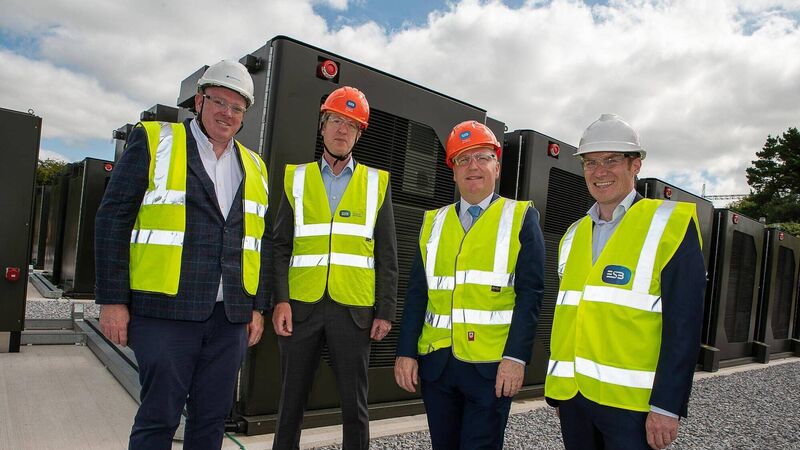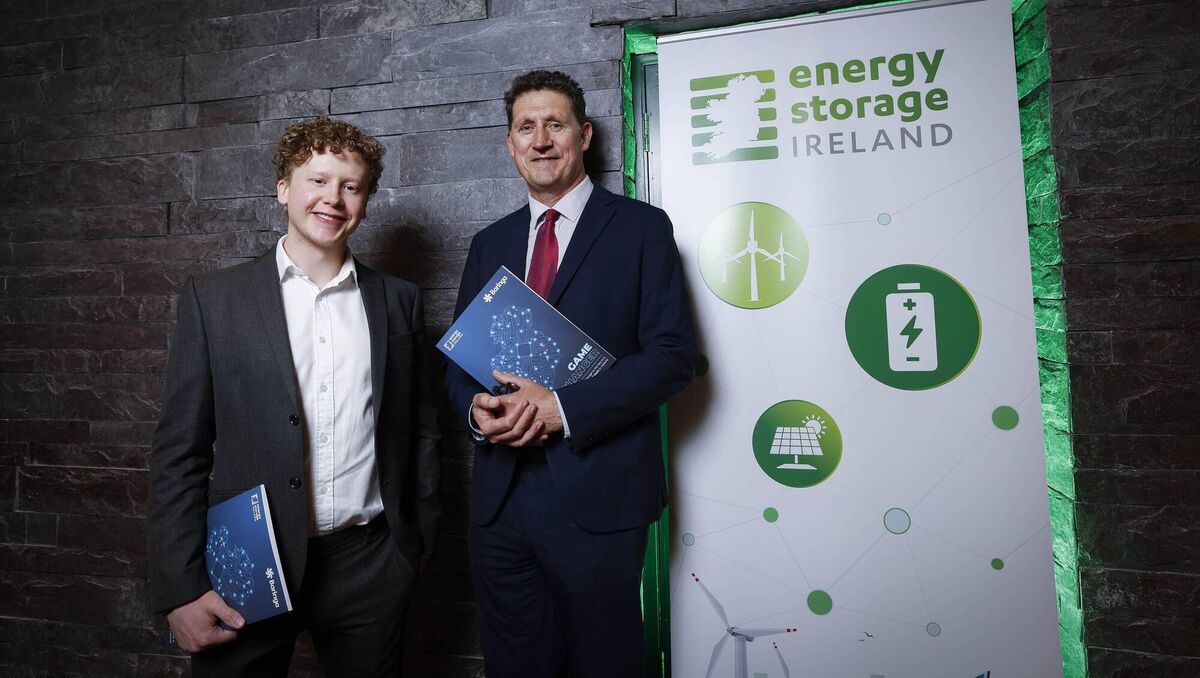Ireland sees big opportunity in battery storage

James Cafferty, MD of Powercomm Group, Paddy Hayes, ESB chief executive, Minister for Public Expenditure and Reform, Michael McGrath, and Paul McCusker, Fluence president of EMEA, at the battery plant at Aghada Power Station, Whitegate, East Cork, which will add 19MW of fast-acting energy storage to offer grid stability and deliver more renewables on Ireland’s electricity system.
Europe is on track to install at least 95 GW of grid-scale battery energy storage systems by 2050, compared to 5GW of installed capacity today — and Ireland can be one of the best locations for it.
That is not just aspiration or ambition talking, it is the result of research from one of Europe’s leading energy analysts.
European battery markets are on track to attract over €70bn in investment by 2050, Aurora Energy Research said.
“The five most attractive markets for battery storage in Europe are Germany, Great Britain, Greece, Ireland and Italy, Aurora assesses, considering factors such as policy support, revenue stacking opportunities and demand for low-carbon flexible energy.
“There is ample scope to increase the size and investment opportunities of European battery markets: 14 of the 24 countries assessed do not yet have a strategy or targets for energy storage deployment, Aurora finds,” the firm said.
Ireland is one of the countries not to have a national strategy in place, and that is now urgent, according to industry body Energy Storage Ireland.
The body’s head, Bobby Smith, said: “I would say the lack of a national strategy for energy storage has been an issue, and the Government, the Department of Environment in particular, is going to produce an energy storage policy strategy later this year.
“For the last few years, although we have had some development in energy storage in Ireland, in particular battery storage, it has been a bit fractured and not all that coordinated.

“That is because we don't have a national strategy. It is urgently needed to set the long-term vision objective and get the key stakeholders aligned and striving towards that. That's going to be the key.
“Right now, unfortunately, we're not going to be able to deliver the energy storage that we need without proper strategy, without proper target alignment of stakeholders,” he said.
Energy Storage Ireland has more than 50 member companies, Mr Smith said.
“We have 55 member companies at this stage from across the energy storage supply chain, and there's a huge amount of projects, energy storage projects out there, that are in the planning system or through the planning system, and are waiting now for the government strategy, and those targets and incentives to now come, so they can start to build projects and invest in projects and get those delivered for 2030. The industry is ready and waiting,” he said.
What is energy storage exactly?
It is absolutely part of climate change solutions and Ireland is not going to be able to deliver renewal targets to 2030 without it, and beyond that, he said.
“Energy storage is the perfect complement to wind and solar energy. It is essentially the backup system needed, particularly in a system with lots of wind and solar generation. Even on a very windy day where a lot of our electricity is generated from wind energy, you need to have reserves in the background in case there is an issue with the power system.
“For instance, if one of the transmission lines runs into a fault and has to shut down, or one of the generators runs into an issue. It doesn't happen all that often, but it does happen. You need to have your substitute reserves that can come in at a moment's notice.
“Those assets can sit there charged, ready to respond at a moment's notice and find energy in the system. And then the other key solution they provide is low carbon energy, when we don't have a lot of wind or solar on the system. For non-windy days, instead of relying on more expensive fossil fuel generation, we can use energy storage that has charged from renewables to fill in the gaps.”
How would it apply in a real-world setting?
According to Mr Smith, battery storage is one form of energy storage, the most common one we have in Ireland and in Europe.
It means that if there are amber alerts that the system is stressed or in danger of becoming overwhelmed, the cavalry would be there to save the day.
“They were used during recent amber alerts to keep the power system stable. If there was potentially a shortfall in electricity to meet demand, battery storage can step in and meet that demand. An issue might be caused when there is an issue such as a power generator, like a large gas plant or a large wind farm, running into a problem — battery storage can step in and fill in that gap, to keep the system stable and keep the electricity flowing, essentially,” Mr Smith said.
There are going to be times when there are gaps for multiple hours or even days where we don't have much wind or we don't have solar generating, where we need longer duration, stores that can provide energy over hours, or even days, according to Mr Smith.
“That's where we're going to see really development in the future. There is a huge amount of interest, both nationally and internationally, about and what we can do and the potential for investment here. It's actually quite an exciting place to be for energy storage. It's almost like a test case for how countries in Europe might follow when they start to build up their renewable resources.”
The vital role that batteries can play in the European power sector’s decarbonisation is set to drive a surge in installations over the next few decades — installed grid-scale capacity will rise to 42GW by 2030, and at least 95GW by 2050, compared to the 5GW installed across the continent today, Aurora Energy Research forecasts.
“These capacity additions represent a cumulative investment opportunity of over €70bn between 2023 and 2050. Over 40% of this capital will be deployed by the end of 2030, Aurora calculates.
“The average battery duration will increase over time, due to growing demand for longer storage as renewable power generation increases. Batteries with over four hours’ storage capacity will account for 61% of total installed battery capacity in 2050, compared with 22% in 2025, Aurora’s modelling shows,” the highly respected British firm said.
The five most attractive battery markets in Europe are Germany, Great Britain, Greece, Ireland and Italy, Aurora assesses, it said.
“Key drivers of market attractiveness include policy and regulatory support, such as specific battery storage targets or rollout plans; financing mechanisms, such as subsidy schemes or opportunities for participation in flexibility or capacity markets; and the outlook for renewable power generation — the higher the share of renewables in a power system, the greater the demand for batteries.
“Ambitious deployment targets have boosted Greece and Italy’s attractiveness — Greece aims to install 6 GW of battery storage by 2030, the highest target in Europe — while good revenue stacking opportunities, where battery operators optimise between markets, supported Great Britain and Ireland’s rankings.”
Aurora said that it considers only six of the countries assessed to have strong government commitments in place, such as Italy’s target to install 3 GW of long-duration batteries by 2030, or Spain’s plan to deploy 2.5 GW of battery storage by 2030.
Research lead for European Power Markets at Aurora Energy Research, Ryan Alexander, said: “Batteries represent an attractive investment opportunity in Europe's energy sector — new projects are announced on a near-daily basis as developers seek to capitalise on the need for storage in the energy transition.
“There will undoubtedly be an early mover advantage for investors: the anticipated surge in demand for batteries over the next decades creates saturation risk, causing revenues to decline as markets become overcrowded. Aurora’s European Battery Markets Attractiveness Report helps investors navigate entry into new markets and maximise their competitive advantage in an increasingly crowded space.”
Flexibility product lead for European Power Markets, Anu Omojola, added that battery storage is a “game changer for the energy transition”.
“However, policymakers across Europe need to take urgent action to enable capacity deployment. Key regulatory challenges around grid connection, network charges, long-term contractability and ancillary services remuneration pose significant risks to the rapid buildout of battery capacity across the continent.”














